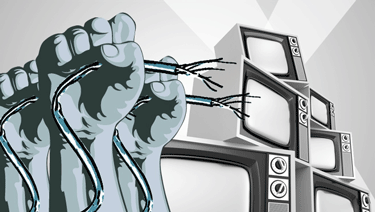How consumers’ monthly spend will change as more devices and services compete for a share of their wallet
By Jeffrey Cole
This is the year that cord-cutting and cord-shaving have shifted into high gear as reliable alternatives to a full cable or satellite bill for many television viewers.
 Years ago, before Over-the-Top (OTT) services were available, the cable companies argued that, if they allowed a la carte selection for channels, the customer would suffer, because at the end of the process they would spend the same amount of money monthly, but receive far fewer channels. These questions of how much money we spend, how much may be freed up if we unbundle, and where that money may go are of intense interest to us at the Center.
Years ago, before Over-the-Top (OTT) services were available, the cable companies argued that, if they allowed a la carte selection for channels, the customer would suffer, because at the end of the process they would spend the same amount of money monthly, but receive far fewer channels. These questions of how much money we spend, how much may be freed up if we unbundle, and where that money may go are of intense interest to us at the Center.
Each year for the past five years, we have tracked how much money the average household spends each month on communication services that didn’t exist 30 or 40 years ago. This doesn’t include landline phones, which our parents and grandparents have had for many generations (and which are rapidly disappearing). We look at mobile phone lines, broadband charges, satellite radio, DVR charges, and cable or satellite charges (for television).
In the U.S., the average household spends $274 per month for services that were not around two generations ago. Of course, some households spend far more than $274, depending on whether they have premium sports or movie packages (which can add hundreds of dollars in monthly charges, as can multiple mobile phone lines or extremely fast broadband).
What’s even more interesting is that when you look at those at or below the poverty level in the U.S., the $274 only drops to $199 per month. Although this may seem very high and unaffordable, consider that to the poorest Americans, mobile phones (specifically smart phones) are no longer a luxury: they are a necessity for basic communications. And the other services are also viewed as necessities.
____________________
The war between the cable and satellite companies, the traditional content providers (Disney, Viacom, CBS, Fox, NBC Universal Comcast) and the new content providers (Netflix, Amazon, Apple– and soon, Facebook, Google and others) will be fought over $40-90 per month.
____________________
During the height of the great recession, we saw many Americans revert from broadband back to dial-up to save approximately $40 a month. Within two months they were back on broadband. The internet they had grown used to with Netflix and YouTube wasn’t feasible with dial-up.
Without many people realizing it, broadband moved from a luxury to a necessity. Although 200 channels of television at $80-100 per month is not technically a necessity, most treat it as if it is. Eighty percent of Americans could use antennas and receive seven-to-10 channels, although without HBO, MTV, CNN or other cable channels. Cable television became for most households, even the poorest ones, an inexpensive source of massive amounts of entertainment and news.
This level of spending ($274 on average and $199 for low-income households) raises important questions: Where does this money come from? What needs are not being met to pay for cell phones, broadband and television? These are all questions the Center is currently exploring.
Playing a public game of chicken
It is clear that the $274 is not going to rise by any significant factor other than inflation for the next five to eight years. The cable companies and content providers get into a vicious competition every three years or so. Providers like Disney (ABC, ESPN, Disney Channel) or Viacom (MTV, Nickelodeon, and Comedy Central) want more money from cable companies to pay for their increased programming costs. Meanwhile, cable companies know that every time they raise their prices more people cut the cord. They play a public game of chicken where the viewers are held hostage as Disney (for example) threatens to pull their channels from cable, and cable companies call on their subscribers to contact Disney and chastise them for their greed.
All of this has made it difficult to raise cable fees.
Telecom companies are also finding it difficult to raise prices, and instead they are returning to unlimited data (many of us have been at unlimited voice for quite a while). Broadband, the newest of the telco services, seems to have a little more room to raise prices, but it is clear that the $274 will remain relatively stable for the foreseeable future.
____________________
In the U.S., the average household spends $274 per month for services that were not around two generations ago. What’s even more interesting is that when you look at those at or below the poverty level in the U.S., the $274 only drops to $199 per month. Although this may seem very high and unaffordable, consider that to the poorest Americans, mobile phones (specifically smart phones) are no longer a luxury: they are a necessity for basic communications. And the other services are also viewed as necessities.
____________________
The war between the cable and satellite companies, the traditional content providers (Disney, Viacom, CBS, Fox, NBC Universal Comcast) and the new content providers (Netflix, Amazon, Apple– and soon, Facebook, Google and others) will be fought over $40-90 per month.
Since Netflix has already won the big war for consumers and owns $10 a month from most Americans, the war is over $30-80 a month.
Actually, Netflix could be getting far more than $10 a month from subscribers (after its recent price hikes). When Netflix was in the red envelope business delivering four or so DVDs by mail, it charged $17.95 a month and became the second biggest customer of the U.S. Postal Service. Netflix made the almost-fatal mistake of dividing the company in two: the DVD business (Qwikster) and the streaming business, charging $7.99 for each. The DVD business quickly faded (although it still exists). But the streaming business took off and now produces $6 billion a year of original programming as well as re-purposed film and television.
If the four DVDs that Netflix mailed each month could command $17.95 several years ago, the new streaming business is worth at least that much (and much more) today. The problem for Netflix is that it can’t quickly move from something that started at $8 a month to $22 a month. Expect regular and small price increases.
After allowing for Netflix, the cord-cutters have about $80 a month to spend, and the cord shavers have $30. The cord shavers may subscribe to Hulu, HBO Now, Amazon, CBS All Access, quickly using up their $40 or choose to spend more. The cord cutters will have more to play with and may add a few more channels– Comedy Central, MTV, Disney Channel, Bravo or whatever suits them.
As we predicted eight years ago, when customers had a choice with regard to ESPN (when it’s not a mandatory part of a basic bundle) only those who love sports are willing to pay $7 per month. All of a sudden it look like the cable companies were right: we will pay the same amount and get fewer channels. Nonetheless, we are in charge and can build packages suited to our tastes.
Google, Facebook, Apple and others are entering the programming world. Amazon is already there, joining Netflix, the studios and networks.
The battle for $30-80 has just begun.
____________

Jeffrey Cole is the director of The Center for the Digital Future at USC Annenberg.
See all columns from the Center.
October 19, 2017

